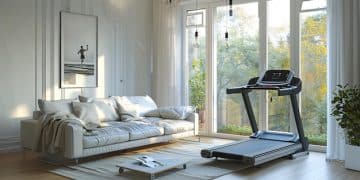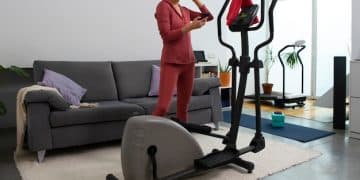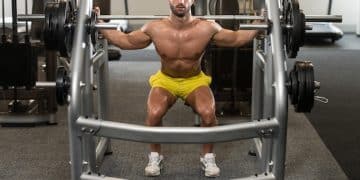Build Your Home Gym on a Budget: Essential Equipment for 2025
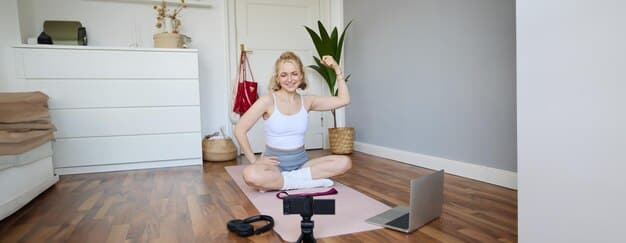
Building an effective and affordable home gym in 2025 prioritizes smart equipment choices over expensive installations, focusing on multi-functional items like adjustable dumbbells and resistance bands to maximize workout potential within a strict budget.
In a world where convenience is king, the allure of a home gym has never been stronger. But for many, the thought of setting one up conjures images of hefty price tags and complex machinery. Thankfully, constructing an effective home gym doesn’t require breaking the bank. This guide will show you How to Build a Home Gym on a Budget: Essential Equipment for 2025, ensuring you can achieve your fitness goals without financial strain.
planning your budget-friendly home gym
Embarking on the journey of building a home gym begins not with equipment, but with a clear, realistic budget. Understanding your financial boundaries is paramount, as it directly influences the types of equipment you can acquire and the overall scope of your fitness space. A well-defined budget prevents overspending and encourages creative solutions for maximizing your workout capabilities.
Before making any purchases, consider the available space in your home. Whether it’s a dedicated room, a corner of a garage, or even a small living room area, the dimensions dictate the kind of equipment that can comfortably fit. Measure your space carefully and visualize how different pieces of gear might be arranged to ensure both functionality and safety.
Think about your primary fitness goals. Are you aiming for strength training, cardiovascular endurance, flexibility, or a combination? Your objectives will guide your equipment selection, ensuring every dollar spent contributes effectively to your desired outcomes. For instance, someone focused on strength might prioritize weights, while a cardio enthusiast might look for jump ropes or an exercise bike.
Setting realistic expectations is also crucial. A budget home gym won’t replicate a commercial facility, but it can certainly provide a robust foundation for consistent, effective workouts. Focus on versatility and quality for the items you do choose, rather than quantity.
Assessing space and needs
The first practical step in your home gym setup is a thorough assessment of your dedicated area. This involves more than just measuring square footage; it’s about understanding the environment. Is there adequate ventilation? Sufficient lighting? Are the floors suitable for exercise, or will you need protective mats?
- Dimensions: Accurately measure the length, width, and height of your chosen space. This prevents awkward purchases and ensures equipment fits well.
- Flooring: Consider how your current flooring will handle weights or intense movements. If necessary, plan for affordable protective mats.
- Ventilation: Proper airflow is essential for comfort and health during workouts. Ensure good ventilation or plan for a fan.
Your fitness level and preferences also play a significant role. If you are a beginner, you might start with foundational bodyweight exercises and gradually add equipment. For more advanced individuals, specific resistance challenges might be a priority. Understanding these elements from the outset streamlines the purchasing process and prevents unnecessary expenditures on items you won’t fully utilize.
Prioritizing essentials over luxuries
When building a home gym on a budget, distinguishing between essential equipment and desirable luxuries is key. The goal is to maximize functionality with minimal investment. This approach often involves selecting multi-functional items that can serve several purposes, thereby reducing the need for specialized, costly machines.
For example, a traditional barbell set with a rack can be expensive and space-consuming. Instead, adjustable dumbbells can provide a wide range of weight options in a compact form. Similarly, while a high-end treadmill might be appealing, a simple jump rope or resistance band offers excellent cardiovascular benefits at a fraction of the cost.
Focus on equipment that targets major muscle groups and supports compound movements. These exercises are highly effective for overall strength and fitness development. Items like resistance bands, kettlebells, and a pull-up bar offer versatility for a full-body workout without requiring extensive investment. Remember, consistency and proper form with basic equipment often yield better results than sporadic use of expensive, complicated machinery.
foundational equipment under $100
Establishing the core of your home gym doesn’t necessitate breaking the bank. Many foundational pieces of equipment essential for a wide range of exercises can be acquired for less than $100. These items are typically portable, versatile, and effective, offering significant value for their cost. They form the building blocks of an accessible fitness routine, especially crucial when budgeting is a primary concern.
These initial investments focus on versatility, allowing you to perform various exercises targeting different muscle groups. They are also relatively small, making them ideal for spaces where square footage is limited. Prioritizing these cost-effective tools ensures that you can begin your fitness journey promptly without waiting to save up for more expensive apparatus.
The beauty of these foundational items lies in their simplicity and effectiveness. They encourage bodyweight exercises, which are excellent for beginners, and can be easily integrated into more advanced routines as strength and skill improve. Moreover, their durability means they can be a long-term asset in your fitness arsenal.
Resistance bands: your versatile companion
Resistance bands are arguably the most versatile and budget-friendly piece of gym equipment. Available in various resistance levels, they can be used for strength training, warm-ups, stretching, and even rehabilitation exercises. Their portability makes them perfect for small spaces and travel.
- Upper Body: Use bands for bicep curls, tricep extensions, shoulder presses, and rows.
- Lower Body: Integrate bands for squats, lunges, glute bridges, and leg presses.
- Flexibility & Mobility: Great for dynamic stretching and improving range of motion.
A set of progressive resistance bands can cost as little as $20-$40 and provide a comprehensive workout. They are fantastic for adding resistance to bodyweight exercises, making them more challenging as you get stronger. The different resistance levels allow for scaling exercises, accommodating both beginners and more experienced individuals.
Their compact nature means they take up virtually no space, easily fitting into a drawer or small bag. This makes them an excellent choice for apartment dwellers or anyone with limited room. Many online resources offer free workout routines tailored specifically for resistance bands, making them an ideal starting point for your home gym.
Jump rope: cardio power on a dime
Often underestimated, a jump rope is a powerhouse for cardiovascular fitness. It’s incredibly efficient for burning calories, improving coordination, and enhancing agility. What’s more, a quality jump rope can be purchased for less than $15, offering an invaluable return on investment for your cardio needs.
Jumping rope can elevate your heart rate quickly, providing an intense workout in a short amount of time. It’s a low-impact alternative to running for many and can be done in a small area, making it ideal for home use. Incorporating various foot patterns and speed variations can keep workouts engaging and challenging.
Beyond its cardio benefits, regular jump rope practice can improve bone density, balance, and proprioception. It’s a full-body exercise that engages multiple muscle groups, from your calves and quads to your shoulders and core. For those looking to add an intense cardio element to their budget gym, a jump rope is an indispensable tool.
Yoga mat: comfort and stability
A yoga mat provides a comfortable and stable surface for bodyweight exercises, yoga, Pilates, and stretching. It cushions your joints and provides grip, preventing slips during dynamic movements. A decent quality mat can be found for under $30, serving as a fundamental piece of equipment for almost any home workout routine.
Beyond its primary use for floor exercises, a yoga mat also defines your workout space, providing a designated area for movement. This can be particularly useful in multi-functional rooms where space needs to be organized. Its portability means it can be rolled up and stored away neatly when not in use.
Choosing a mat with adequate thickness (around 6mm) will provide sufficient cushioning for most activities, offering protection for knees, elbows, and spine during floor work. The right mat enhances safety and comfort, encouraging longer, more effective workout sessions without discomfort.
mid-range equipment for less than $300
Once you’ve established your foundational equipment, the next step involves strategically investing in mid-range items that offer increased resistance and versatility for your home gym. These tools, while a bit more expensive than the initial set, provide substantial enhancements to your workout capabilities without demanding a significant financial outlay. The focus remains on maximizing utility and avoiding single-purpose equipment that could quickly drain your budget.
This category of equipment is designed to build upon your current fitness level, allowing for more advanced strength training, more diverse cardio options, and greater overall challenge. It represents a smart progression in your home gym setup, ensuring that your investment yields tangible improvements in your physical conditioning.
When selecting items in this price range, look for durability and multi-functionality. These are often the pieces that will see the most consistent use and contribute significantly to your long-term fitness goals. Smart choices here can prevent the need for more expensive upgrades down the line.
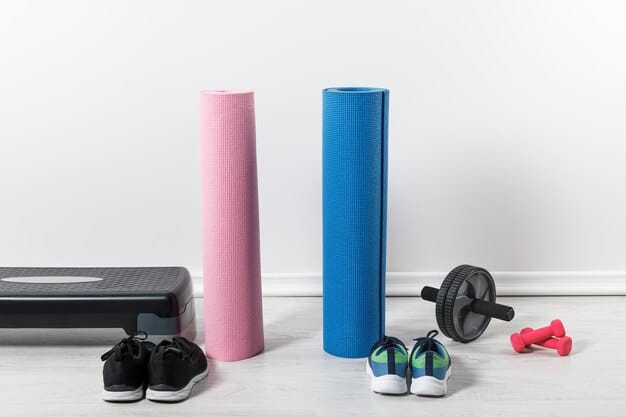
Adjustable dumbbells: the smart weight solution
Adjustable dumbbells are a game-changer for any home gym, especially on a budget. Instead of buying individual sets of dumbbells, which take up considerable space and cost a lot, adjustable versions allow you to change weights with a simple dial or pin. A quality pair can range from $150 to $300, providing a wide array of weight options in a single compact unit.
These dumbbells are excellent for progressive overload, allowing you to gradually increase the weight as you get stronger without needing to purchase new equipment. They are suitable for all major strength exercises, including squats, presses, rows, and curls. Their space-saving design is a significant advantage for home users.
Investing in adjustable dumbbells replaces the need for a full rack of fixed weights, making them cost-effective in the long run. They are perfect for building strength, muscle mass, and endurance through various exercises. Before purchasing, check reviews for ease of weight adjustment and overall durability.
Kettlebells: functional strength in one piece
Kettlebells are another highly effective multi-functional piece of equipment. They are excellent for developing functional strength, power, and cardiovascular endurance through dynamic movements like swings, snatches, and cleans. A single kettlebell can offer a full-body workout, and you can generally acquire a good quality one for $50-$100, depending on the weight.
Unlike traditional dumbbells, the unique weight distribution of a kettlebell challenges your stability and grip, engaging more muscle groups during exercises. They are superb for improving core strength, explosiveness, and overall athletic performance. Starting with a moderate weight (e.g., 16kg/35lb for men, 8-12kg/18-26lb for women) is often recommended.
Kettlebells are relatively compact and easy to store. Their effectiveness for combining cardio and strength makes them a valuable addition to a budget home gym. Many online tutorials and programs are available to guide you through proper kettlebell techniques, ensuring you get the most out of your investment safely.
Pull-up bar: vertical challenge at home
A pull-up bar is an excellent investment for upper body strength, particularly for back and bicep development. Doorway pull-up bars are the most common and affordable option, typically costing $30-$70. They require no drilling and can be easily installed and removed from most doorframes.
- Back Strength: Essential for developing a strong and wide back.
- Bicep & Forearm Development: Directly targets these muscle groups.
- Core Engagement: Engages the core for stability during movements.
Beyond traditional pull-ups, a doorway pull-up bar can also be used for chin-ups (palms facing you) and, if placed on the floor, for push-ups or core exercises like incline push-ups or tricep dips. Some models also allow for inverted rows, which are great for building back strength for beginners.
Ensure the pull-up bar you choose is durable and fits securely in your doorway. Always check the weight capacity and follow installation instructions properly to ensure safety during use. A pull-up bar offers challenging bodyweight exercises that are difficult to replicate with other equipment at this price point.
optimizing space and storage solutions
Optimizing your home gym space is as crucial as the equipment itself, especially when operating on a budget and often within limited square footage. Effective storage solutions not only keep your area tidy and safe but also make your workouts more efficient by ensuring equipment is readily accessible. Clutter can be a major demotivator, so a well-organized space contributes significantly to workout consistency.
Smart storage doesn’t necessarily mean expensive furniture. Many affordable and DIY solutions can transform a small area into a highly functional workout zone. The goal is to maximize vertical space, utilize often-overlooked corners, and find versatile storage units that can adapt to your growing equipment collection.
Prioritizing organization from the beginning helps maintain motivation and prevents equipment from becoming an obstacle rather than an aid. A dedicated, well-arranged fitness corner can make even the most compact space feel like a legitimate gym.
Wall-mounted racks and hooks
One of the most efficient ways to store equipment in a small home gym is to utilize vertical space. Wall-mounted racks and hooks are affordable solutions for hanging resistance bands, jump ropes, yoga mats (if they come with hanging straps), and even lightweight dumbbells. These can be purchased for $20-$50 and keep your floor clear, reducing trip hazards and making cleaning easier.
For items like yoga mats, simple adhesive hooks can suffice. For heavier items like resistance bands or jump ropes, screw-in hooks designed for utility purposes work well. Some dedicated gym wall organizers are available, often featuring multiple hooks and slots for various accessories, offering a neat and professional look.
Before installing, ensure you are drilling into studs for proper support, especially for heavier items. Always consider the weight capacity of the hooks and racks. This method is exceptionally effective for keeping frequently used items within arm’s reach while maintaining a spacious environment.
Under-bed storage and collapsible items
If you’re truly limited on space, consider utilizing under-bed storage or investing in collapsible equipment. Under-bed containers can neatly store smaller items like resistance bands, ankle weights, or even a rolled-up yoga mat. These containers are inexpensive and keep items out of sight when not in use.
Some equipment is specifically designed to be collapsible or stackable. For example, some adjustable step platforms fold flat, and certain resistance band sets come with a compact carrying case. While not every piece of equipment offers this feature, prioritizing it where possible helps maximize efficiency in multi-functional rooms.
Even small spaces can be transformed with creative storage ideas. The key is to think vertically and multi-purposefully. A simple storage cube or a decorative basket can also hide away smaller items, making your workout area blend seamlessly with your living space.
smart shopping strategies for 2025
Building a home gym on a budget for 2025 requires more than just knowing what equipment to buy; it demands smart shopping strategies. The market for fitness gear is dynamic, with new products and deals emerging regularly. Being an informed consumer can save you substantial amounts of money without compromising on quality or functionality. This involves patience, research, and an openness to various purchasing channels.
As we move into 2025, online marketplaces and direct-to-consumer brands continue to offer competitive pricing and variety. Leveraging these platforms effectively, along with traditional avenues like second-hand markets, is crucial for maximizing your budget.
Beyond just looking for the lowest price, consider the longevity and warranty of the products. A slightly higher initial investment in a durable piece of equipment can save money on replacements in the long run. Strategic shopping ensures that every dollar spent contributes to a sustainable and effective home gym.
Second-hand markets and online forums
One of the best ways to save money on gym equipment is by exploring second-hand markets. Websites like Craigslist, Facebook Marketplace, and local online classifieds often feature used fitness equipment in good condition at significantly reduced prices. You can frequently find items like adjustable dumbbells, kettlebells, and even exercise bikes for a fraction of their retail cost.
Fitness-focused online forums and local community groups can also be valuable resources for buying, selling, or even trading equipment directly with other enthusiasts. Members often share insights on deals, and some might be upgrading their own gear, making their older but still functional equipment available.
When buying used, always inspect the item thoroughly for any damage, wear and tear, or defects. Test any moving parts to ensure they function correctly. While buying second-hand presents greater savings, it requires a careful eye to ensure you’re getting a safe and functional product.
Seasonal sales and discount periods
Timing your purchases with seasonal sales events can lead to significant savings. Major retail holidays like Black Friday, Cyber Monday, and post-holiday sales (e.g., after Christmas or New Year’s) are prime opportunities to snag deals on fitness equipment. Many retailers offer substantial discounts during these periods to clear inventory.
Summer sales, end-of-year clearances, and even specific health and fitness promotions throughout the year can also yield good prices. Subscribing to newsletters from your favorite fitness brands or sporting goods stores can give you early access to sale announcements and exclusive discounts.
Patience is key here. If you’re not in an immediate rush, waiting for a major sale event could mean the difference of dozens or even hundreds of dollars on larger items. Create a wish list and set price alerts if possible, so you’re notified when desired items go on sale.
DIY solutions and basic builds
For the truly budget-conscious, DIY solutions can be an excellent way to expand your home gym capabilities. Simple items like concrete-filled buckets for weights, sandbags for versatile resistance, or even a sturdy tree branch for pull-ups can provide effective alternatives to commercial equipment.
Basic builds, like a simple wooden plyometric box or a PVC pipe parallette set, require minimal materials and basic tools but can add significant versatility to your workout routine. Numerous online tutorials and guides provide step-by-step instructions for these types of projects.
While DIY solutions require some time and effort, they allow for extreme customization and cost savings. Always prioritize safety and ensure any self-built equipment is stable and robust enough for its intended use. This approach is not only economical but also adds a personalized touch to your fitness space.
safety and maintenance tips
Even the most budget-friendly home gym requires careful attention to safety and regular maintenance. Neglecting these aspects can lead to accidents, injuries, or premature wear and tear on your equipment, ultimately costing more in the long run. A proactive approach to safety and maintenance ensures your workout space remains effective and secure for years to come.
Safety extends beyond just the equipment itself; it encompasses proper form during exercises, adequate warm-ups and cool-downs, and an organized environment free of hazards. Similarly, regular cleaning and inspection of your gear prolong its lifespan and maintain its functionality.
Establishing a routine for checks and cleaning will help identify potential issues before they become serious problems. This proactive mindset is key to a sustainable and injury-free home fitness journey.
Regular equipment checks
Make it a habit to inspect your equipment regularly. Check resistance bands for tears or fraying, dumbbells for any loose parts, and pull-up bars for secure attachment. Even a small defect can lead to a significant injury during a workout.
- Visual Inspection: Look for any signs of wear, cracks, or damage on all equipment.
- Functionality Check: Test adjustable dumbbells to ensure weights lock securely. Check the stability of any racks or bars.
- Tighten Bolts/Screws: If you have any assembled equipment, periodically check and tighten all bolts and screws.
Promptly address any issues you find. A frayed resistance band should be replaced immediately, and a wobbly pull-up bar needs to be re-secured or taken down. Don’t risk injury for the sake of delaying a small repair or replacement.
This routine check can be done weekly or before each workout, depending on the frequency of use. It’s a small investment of time that pays dividends in safety and peace of mind.
Proper cleaning and storage
Keeping your equipment clean and stored correctly not only extends its life but also prevents the buildup of bacteria and keeps your workout area hygienic. Sweat and dust can degrade materials over time, so regular cleaning is essential.
Wipe down surfaces of dumbbells, kettlebells, and mats with a damp cloth or a mild disinfectant spray after each use. For resistance bands, a gentle soap and water solution is usually sufficient, followed by air drying. Ensure equipment is completely dry before storing to prevent mildew or rust.
Store equipment in a cool, dry place away from direct sunlight, which can degrade certain materials like rubber over time. Use your wall-mounted hooks, shelves, or storage bins to keep items organized and off the floor. Proper storage minimizes clutter and reduces the risk of accidental trips or falls.
Using proper form to prevent injury
No amount of expensive equipment can compensate for poor form. Learning and maintaining proper exercise technique is the single most important factor in preventing injuries and maximizing workout effectiveness. Even with the simplest equipment, incorrect movements can strain muscles and joints.
Utilize online resources, reputable fitness apps, or consider a few sessions with a certified personal trainer if your budget allows for it, even virtually. Watch videos and read detailed instructions on how to perform each exercise correctly before attempting it with weights or resistance.
Start with lighter resistance or just bodyweight to master the movement pattern before adding load. Listen to your body and don’t push through sharp pain. Consistency with good form will yield better, safer results than sporadic, heavy lifting with improper technique. Your body is your most valuable asset, treat it with care.
Advanced budget additions and future upgrades (2025 considerations)
As you progress in your fitness journey and your initial budget home gym proves its worth, you might begin to consider advanced additions or future upgrades. By 2025, the landscape of affordable fitness technology and equipment continues to evolve, offering even more innovative solutions. These additions aren’t about luxury; they’re about strategically optimizing your training potential without veering off your budget-conscious path. The key here is not to rush into purchases but to thoughtfully assess what will genuinely enhance your specific fitness goals and complement your existing setup.
The concept of “budget” also adapts over time; as your income stabilizes or priorities shift, what was once out of reach might become attainable. This section explores smart ways to continue expanding your home gym’s capabilities, keeping future trends and smart investments in mind.
Remember, sustainability in a home gym is about continuous adaptation and smart choices, ensuring that every new piece of equipment serves a clear purpose and adds significant value to your fitness routine.
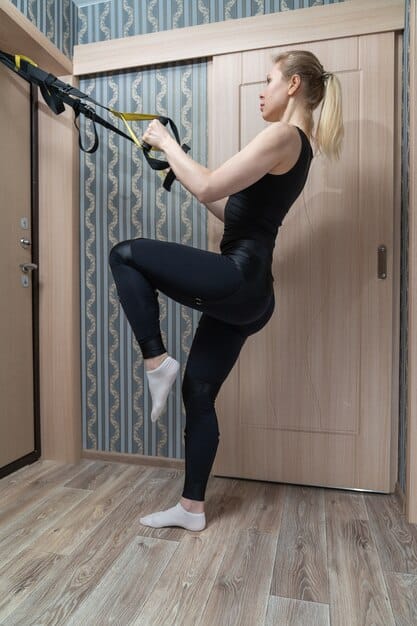
Foam roller: recovery on a budget
While often overlooked in initial gym setups, a foam roller is a fantastic tool for recovery, flexibility, and muscle soreness relief. It acts as a self-massage tool, helping to release tight muscles and improve blood flow. A basic foam roller can be acquired for $20-$40, making it an excellent budget-friendly addition that significantly enhances your post-workout routine.
Regular use of a foam roller can help prevent injuries, improve range of motion, and reduce muscle stiffness. It’s particularly useful after intense strength training sessions or for addressing common trigger points. Many online tutorials explain how to use a foam roller effectively for various muscle groups.
Adding a foam roller to your home gym immediately elevates your recovery practices, ensuring you’re ready for your next workout. It’s a non-equipment-intensive way to prioritize self-care and muscle health, which is crucial for long-term fitness success.
Adjustable workout bench: versatile support
An adjustable workout bench, though a slightly larger investment ($100-$250), can significantly expand the range of exercises you can perform. It allows for incline and decline presses, various dumbbell exercises, step-ups, and more, effectively transforming your free weights into a more versatile training system.
Look for a bench that is sturdy, has multiple incline settings, and can support your weight plus the weight you intend to lift. Foldable options are available for those with limited space, making them easier to store when not in use.
While it might be a future upgrade, an adjustable bench opens up a broader spectrum of exercises, particularly if you’re serious about strength training with dumbbells or resistance bands. It provides stable support for both upper and lower body movements, enhancing safety and effectiveness.
Smart fitness apps and online programs (2025 trend)
As we move further into 2025, smart fitness apps and online programs are becoming increasingly sophisticated and affordable. Many offer personalized workout plans, progress tracking, and even virtual coaching at a fraction of the cost of a personal trainer. Some apps are free, while premium versions might have a low monthly subscription (e.g., $10-$30 per month).
These digital resources provide structure, motivation, and a diverse library of exercises. They can help you make the most of your existing equipment by guiding you through effective routines tailored to your goals and available gear. Many even integrate with wearables for comprehensive health tracking.
Leveraging these digital tools is a smart way to continuously challenge yourself and stay engaged with your fitness journey without having to buy new physical equipment. They offer guidance, variety, and accountability—all essential elements for long-term adherence to a fitness routine.
| Key Point | Brief Description |
|---|---|
| 💸 Budget First | Define your budget and space limits before buying any equipment. |
| ⚙️ Multi-functional Gear | Prioritize versatile items like adjustable dumbbells and resistance bands. |
| 🛒 Smart Shopping | Utilize second-hand markets, sales, and consider DIY options. |
| 🛡️ Safety First | Regularly check equipment, clean, and focus on proper exercise form. |
frequently asked questions
To start a home gym with minimal investment, essential items include a set of resistance bands, a jump rope, and a yoga mat. These three items together typically cost less than $70. They allow for a wide range of bodyweight and resistance exercises, providing a solid foundation for cardiovascular fitness, strength training, and flexibility.
When buying used equipment, thoroughly inspect it for any damage, cracks, or loose parts. Test all adjustable mechanisms and ensure they lock securely. For items like pull-up bars, verify they meet safety standards and are properly installed. With any equipment, new or used, consistently check for wear and tear before each use and prioritize proper exercise form to prevent injuries.
Yes, adjustable dumbbells are highly recommended for a budget home gym. While their upfront cost is higher than fixed dumbbells, they offer a wide range of weights in a compact design, saving significant space and long-term costs. They are incredibly versatile, accommodating various strength levels and exercises, making them a smart and efficient investment for progressive training.
Regularly wipe down equipment surfaces with a damp cloth or mild disinfectant to remove sweat and prevent bacterial buildup. For rubber items like resistance bands, use a gentle soap and water solution and air dry completely. Store equipment in a cool, dry place away from direct sunlight. Periodically check nuts, bolts, and connections on any assembled items to ensure they remain tightened and secure.
Absolutely. A full-body workout is entirely achievable with budget-friendly equipment. Resistance bands offer versatile resistance for all muscle groups, while a jump rope provides excellent cardio. Bodyweight exercises, supported by a yoga mat, are foundational for strength. Kettlebells or adjustable dumbbells can add significant challenge for compound movements. Combining these allows for comprehensive, effective workouts targeting every major muscle group.
conclusion
Building a home gym on a budget by 2025 is not just feasible, but increasingly practical and effective. By strategically prioritizing multi-functional equipment, leveraging smart shopping avenues, and committing to proper safety and maintenance, you can create a personalized fitness space that rivals commercial gyms in functionality without their hefty price tag. The key lies in thoughtful planning, embracing versatility, and unwavering consistency. Your fitness journey is an investment in yourself, and a well-equipped, budget-friendly home gym can be the cornerstone of a healthier, more active lifestyle.
